Direct Line Group Plc Bundle
Who Really Owns Direct Line Group Plc?
Unraveling the ownership of Direct Line Group (DLG) is key to understanding its current strategy and future prospects, especially given recent developments. A pivotal moment arrived with Aviva plc's £3.7 billion offer in December 2024, reshaping the company's ownership landscape. This analysis delves into the evolution of Direct Line Group Plc SWOT Analysis, from its origins as a disruptor in the UK insurance market to its present-day position.
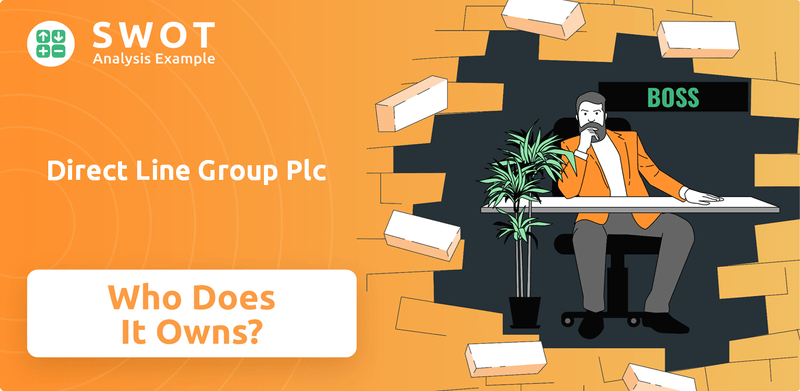
Understanding the Direct Line Group Plc SWOT Analysis is essential for investors and stakeholders alike. The company, a major player in the UK insurance sector, has a fascinating history, starting in 1985. Examining "Who owns Direct Line" and the broader "Direct Line ownership" structure reveals the forces that have shaped its trajectory and will continue to do so. This exploration covers everything from the founding vision to the potential Aviva acquisition, providing a comprehensive view of the DLG company.
Who Founded Direct Line Group Plc?
The origins of Direct Line Group Plc (DLG) trace back to 1985, when it was established as an insurance division within The Royal Bank of Scotland Group (RBS). The founders, Peter Wood and Martin Long, pioneered a telephone-only insurance model, a significant innovation at the time. This approach aimed to simplify the insurance process by removing intermediaries.
Peter Wood, a prominent figure in the UK entrepreneurial landscape, also founded esure insurance. Wood's role in launching Direct Line was pivotal, though he did not retain a capital stake in the company. His compensation was linked to the performance of Direct Line, resulting in substantial earnings in the early 1990s. Martin Long, another key player, later founded Churchill in 1989, which was subsequently acquired by RBS Group in 2003.
Early ownership of Direct Line was effectively held by RBS, which provided the initial financial backing. Details regarding the specific equity splits or shareholdings of the founders during the company's inception are not publicly available, given its initial status as an internal division. The company's evolution from an internal division to a publicly traded entity marks a significant shift in its ownership structure.
Peter Wood's vision led to the creation of the first telephone-only insurance company in the UK.
Martin Long played a crucial role in the company's inception and later founded Churchill.
Initially, ownership was held by The Royal Bank of Scotland Group (RBS).
Direct Line's telephone-only model was a significant innovation in the insurance industry.
The company evolved from an internal division of RBS to a publicly traded entity.
Peter Wood and Martin Long were instrumental in the founding of Direct Line.
Understanding the Direct Line Group Plc (DLG) ownership structure requires looking at its initial setup and subsequent developments. The company's journey, as highlighted in Brief History of Direct Line Group Plc, began as an internal division of RBS. This early phase saw RBS as the primary owner, providing the necessary capital and infrastructure. Over time, Direct Line evolved, eventually becoming a publicly traded entity, which significantly altered its ownership dynamics. This transition marked a shift from a single corporate owner to a structure involving institutional and individual shareholders.
Direct Line Group Plc SWOT Analysis
- Complete SWOT Breakdown
- Fully Customizable
- Editable in Excel & Word
- Professional Formatting
- Investor-Ready Format
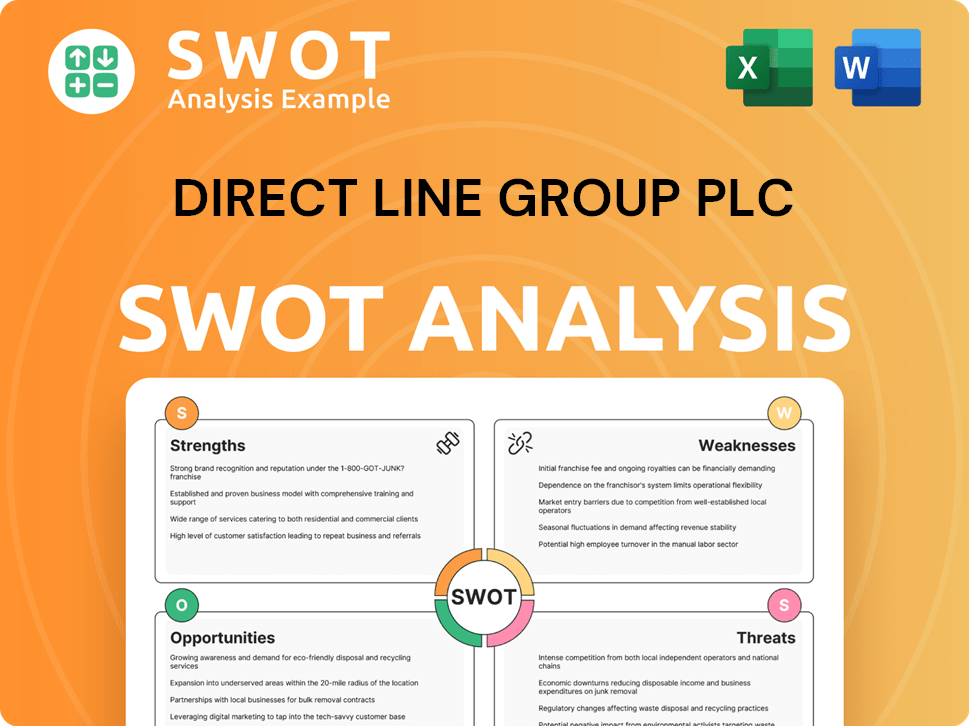
How Has Direct Line Group Plc’s Ownership Changed Over Time?
The evolution of Direct Line Group's ownership began with its separation from The Royal Bank of Scotland Group (RBS). In 2012, Direct Line Group was established as an independent insurance entity, paving the way for its initial public offering (IPO). The IPO occurred in October 2012, with RBS offering a 30% stake in the business. The shares were priced between 160p and 195p, which valued the company at approximately £2.663 billion.
Following the IPO, RBS gradually reduced its ownership. It sold an additional 17% in March 2013, decreasing its stake to 48.5%, and another 20% in September 2013. RBS completed its full divestment by selling the remaining shares in February 2014. This marked a significant shift in the ownership structure of what is now known as Direct Line Group Plc, transforming it into a publicly traded company.
| Event | Date | Details |
|---|---|---|
| Formation as a Standalone Company | 2012 | Direct Line Group was created as a separate entity from RBS. |
| Initial Public Offering (IPO) | October 2012 | RBS sold a 30% share of the business. |
| RBS Stake Reduction | March 2013 | RBS sold an additional 17%, reducing its stake to 48.5%. |
| Further Stake Reduction | September 2013 | RBS sold an additional 20%. |
| Full Divestment by RBS | February 2014 | RBS completed its full divestment of its remaining shares. |
Currently, Direct Line Insurance Group plc has 97 institutional owners and shareholders who have filed 13D/G or 13F forms with the SEC, holding a total of 220,886,174 shares. Major institutional shareholders include Fidelity Low-Priced Stock Fund (FLPSX), Vanguard Total International Stock Index Fund Investor Shares (VGTSX), Artisan International Small-Mid Fund Investor Shares (ARTJX), and Vanguard Developed Markets Index Fund Admiral Shares (VTMGX). Societe Generale has reported significant voting rights in the company, with its total voting rights in Direct Line at 8.1802% as of June 9, 2025. The current market capitalization of Direct Line Group is £3.92 billion as of June 14, 2025.
The ownership of Direct Line Group has evolved significantly since its IPO, with RBS divesting its stake over time.
- Direct Line Group is now a publicly traded company.
- Major institutional investors hold significant shares.
- The company's market capitalization is substantial.
Direct Line Group Plc PESTLE Analysis
- Covers All 6 PESTLE Categories
- No Research Needed – Save Hours of Work
- Built by Experts, Trusted by Consultants
- Instant Download, Ready to Use
- 100% Editable, Fully Customizable
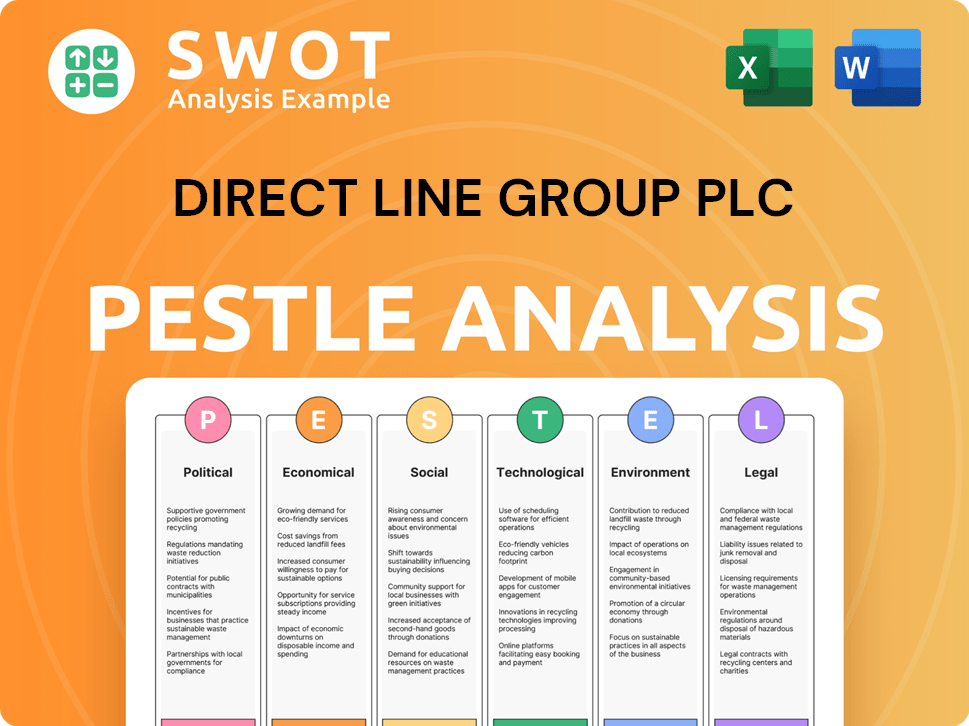
Who Sits on Direct Line Group Plc’s Board?
The current Board of Directors at Direct Line Group (DLG) is responsible for setting the long-term strategy and acting in the best interests of shareholders, employees, customers, and other stakeholders. As of April 2025, Danuta Gray serves as the Chair of the Board, having joined in February 2017 and becoming Chair in August 2020. Adam Winslow is the Chief Executive Officer, appointed in the first quarter of 2024. This leadership team guides the company's strategic direction and ensures effective governance.
The company's governance structure emphasizes adherence to high corporate governance standards. While specific details on the representation of major shareholders or independent seats are not fully detailed in the provided search results, the board's composition and oversight play a critical role in the company's operations. The board's decisions impact various aspects of the business, including financial performance and strategic initiatives. Understanding the board's structure provides insight into how the company is managed and controlled. For more information on the Marketing Strategy of Direct Line Group Plc, refer to the provided resource.
| Position | Name | Date of Appointment/Change |
|---|---|---|
| Chair of the Board | Danuta Gray | August 2020 |
| Chief Executive Officer | Adam Winslow | Q1 2024 |
| Total Ordinary Shares in Issue (as of May 12, 2025) | 1,311,388,157 |
The voting structure for Direct Line Group's shares generally follows a one-share-one-vote principle, with ordinary shareholders entitled to one vote per share held. Recent events highlight the influence of voting power, particularly concerning the proposed acquisition by Aviva. On March 10, 2025, shareholders voted in favor of resolutions to approve the scheme of arrangement for the acquisition by Aviva plc, indicating support for the transaction, which valued the company at approximately £3.7 billion. The collective voting power of institutional investors significantly influences major decisions within the company.
Shareholders of Direct Line Group (DLG) exercise their influence through voting rights, primarily on a one-share-one-vote basis. Major decisions, such as the Aviva acquisition, are subject to shareholder approval.
- Shareholders voted in favor of the Aviva acquisition.
- Institutional investors hold significant voting power.
- The total number of ordinary shares in issue was 1,311,388,157 as of May 12, 2025.
- The acquisition by Aviva was valued at approximately £3.7 billion.
Direct Line Group Plc Business Model Canvas
- Complete 9-Block Business Model Canvas
- Effortlessly Communicate Your Business Strategy
- Investor-Ready BMC Format
- 100% Editable and Customizable
- Clear and Structured Layout
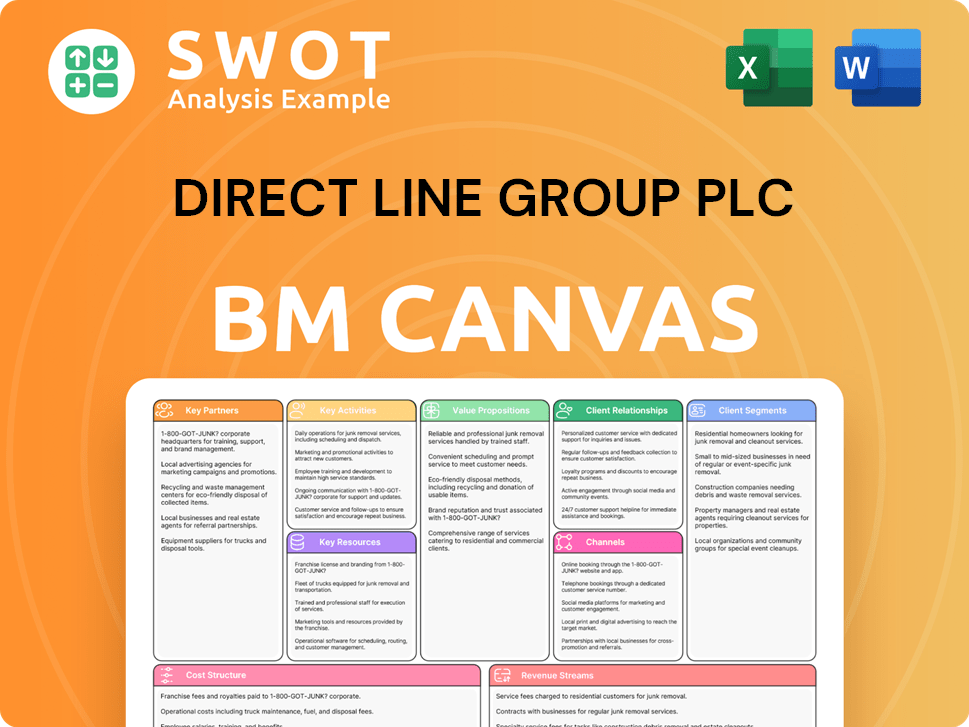
What Recent Changes Have Shaped Direct Line Group Plc’s Ownership Landscape?
Over the past few years, the ownership of Direct Line Group has been significantly influenced by strategic moves and potential acquisitions. A pivotal event was the recommended cash and share offer from Aviva plc, announced on December 23, 2024. This transaction valued the entire diluted share capital of Direct Line at approximately £3.7 billion, with each share valued at 275 pence. Direct Line's board recommended the offer, and shareholders voted in favor on March 10, 2025. The acquisition's completion is expected around mid-2025, subject to regulatory approvals. Upon completion, Aviva shareholders are expected to own approximately 87.5% and Direct Line shareholders about 12.5% of the combined company.
Prior to Aviva's successful bid, Direct Line Group also saw interest from other potential acquirers. In February 2024, Belgian insurer Ageas considered a bid of around €3.1 billion but ultimately did not make an offer. These activities underscore the trend of consolidation within the insurance sector and highlight the attractiveness of Direct Line Group's market position. Institutional ownership remains a key factor in the DLG company's structure, with significant holdings as of June 12, 2025. Also, there have been recent adjustments in voting rights reported, such as Societe Generale's total voting rights decreasing slightly to 7.8667% as of May 19, 2025, but increasing to 8.1802% by June 9, 2025.
Direct Line Group's 2024 financial results showcase significant progress in its turnaround strategy, initiated in July 2024. The company reported a 25% increase in gross written premiums and associated fees, a £395 million increase in ongoing operating profit, and a 12-point improvement in its net insurance margin to 3.6%. Motor insurance returned to profitability in 2024, and the company aims for at least £100 million in gross run-rate cost savings by the end of 2025. These operational improvements likely contributed to the company's appeal as an acquisition target, influencing who owns Direct Line.
| Key Dates | Details | Impact |
|---|---|---|
| December 23, 2024 | Aviva plc announced a recommended cash and share offer. | Valued Direct Line at approximately £3.7 billion. |
| February 2024 | Ageas considered a bid. | Demonstrated interest in Direct Line Group. |
| March 10, 2025 | Shareholders voted in favor of the Aviva acquisition. | Signaled shareholder approval of the deal. |
Aviva's acquisition will significantly change the Direct Line ownership structure. Aviva shareholders will own approximately 87.5% of the combined company. Direct Line shareholders will own about 12.5%.
Institutional owners hold a substantial portion of Direct Line shares. Recent voting rights adjustments were reported for Societe Generale. These adjustments indicate shifts in ownership dynamics.
Direct Line Group's 2024 financial results showed progress. The company saw a 25% increase in gross written premiums. Motor insurance returned to profitability in 2024.
Direct Line is targeting at least £100 million in cost savings by the end of 2025. The company's improvements made it an attractive acquisition target. The acquisition's completion is expected around mid-2025.
Direct Line Group Plc Porter's Five Forces Analysis
- Covers All 5 Competitive Forces in Detail
- Structured for Consultants, Students, and Founders
- 100% Editable in Microsoft Word & Excel
- Instant Digital Download – Use Immediately
- Compatible with Mac & PC – Fully Unlocked
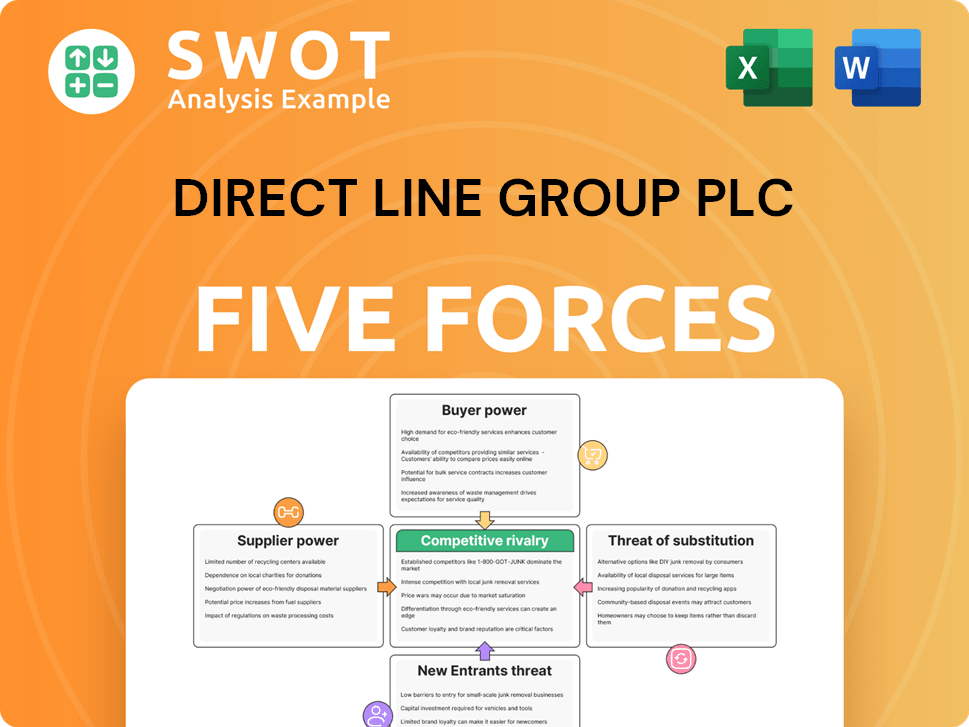
Related Blogs
- What are Mission Vision & Core Values of Direct Line Group Plc Company?
- What is Competitive Landscape of Direct Line Group Plc Company?
- What is Growth Strategy and Future Prospects of Direct Line Group Plc Company?
- How Does Direct Line Group Plc Company Work?
- What is Sales and Marketing Strategy of Direct Line Group Plc Company?
- What is Brief History of Direct Line Group Plc Company?
- What is Customer Demographics and Target Market of Direct Line Group Plc Company?
Disclaimer
All information, articles, and product details provided on this website are for general informational and educational purposes only. We do not claim any ownership over, nor do we intend to infringe upon, any trademarks, copyrights, logos, brand names, or other intellectual property mentioned or depicted on this site. Such intellectual property remains the property of its respective owners, and any references here are made solely for identification or informational purposes, without implying any affiliation, endorsement, or partnership.
We make no representations or warranties, express or implied, regarding the accuracy, completeness, or suitability of any content or products presented. Nothing on this website should be construed as legal, tax, investment, financial, medical, or other professional advice. In addition, no part of this site—including articles or product references—constitutes a solicitation, recommendation, endorsement, advertisement, or offer to buy or sell any securities, franchises, or other financial instruments, particularly in jurisdictions where such activity would be unlawful.
All content is of a general nature and may not address the specific circumstances of any individual or entity. It is not a substitute for professional advice or services. Any actions you take based on the information provided here are strictly at your own risk. You accept full responsibility for any decisions or outcomes arising from your use of this website and agree to release us from any liability in connection with your use of, or reliance upon, the content or products found herein.